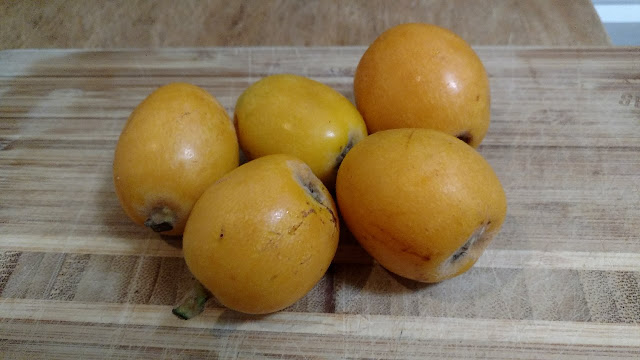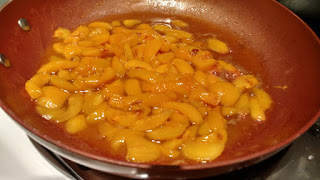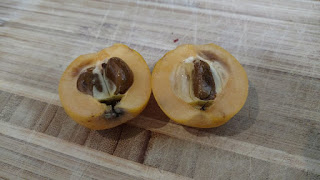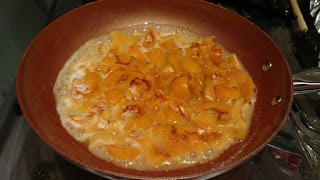
Recipe: Loquat sauce a versatile topping
 |
| Among the first stone fruit of summer, loquats can be used like peaches. (Photos: Debbie Arrington |
The first loquats I ever ate grew on a mystery tree that sprouted in the back of our Long Beach yard. (I assumed it was planted by birds.)
The fast-growing tree had interesting, textured foliage, making it a handsome volunteer. The roundish yellow fruit were a bonus.
But what to do with them? First, remember loquats have nothing to do with kumquats. Think peach, not citrus.
Loquats seem to be all big brown seeds, wrapped in juicy fruit. The flesh is tangy, almost tart, until fully ripe when loquats become honey sweet.
Nicknamed Japanese plum, the loquat has been cultivated in Japan for more than a thousand years. Native to China, it’s also very popular in Korea, India and Pakistan. Loquat comes in several varieties, most 1 to 2 inches long and born in clusters. The skin may be smooth or downy, yellow or orange or blushed with red. The flesh ranges from creamy white to apricot orange.
Loquats are among the first stone fruit of spring, but they have a big head start. With fragrant white flowers, the trees bloom in October or November. If the winter is mild, the loquats ripen in April and May.
Loquats have a tropical taste; part peach, citrus and mango. Such a combination is worth the effort it takes to peel and seed these small fruit.
 |
| Loquat sauce goes equally well in sweet or savory dishes. |
As for what to do with them, loquats can substitute for peaches in a wide range of recipes. But I think they’re best when their individuality is allowed to stand out, complementing that sweet-tart tropical taste.
This sauce is equally at home on top of pork tenderloin or vanilla ice cream. It also works well with grilled chicken, roast duck or flan.
Experiment with spices. For savory dishes, add ¼ teaspoon of red chili flakes or ground ginger along with the jelly.
Also, try substituting ½ cup fresh strawberries for half the sliced loquats, then use strawberry jam as the sweetener; a very good combination with grilled pork or pound cake.
 |
| The big seeds are a distinguishing feature of loquats. |
Quick loquat sauce
Makes about 1 cup
Ingredients:
1 cup loquats, peeled, seeded and sliced
Juice of ½ orange (about ¼ cup)
2 tablespoons butter
2 tablespoons pear jelly, strawberry jam or orange marmalade
Instructions :
 |
| Once the ingredients are in the pan, the sauce goes quickly. |
Comments
0 comments have been posted.Sacramento Digs Gardening to your inbox.
Food in My Back Yard Series
May 6: Maintain soil moisture with mulch for garden success
April 29: What's (already) wrong with my tomato plants?
April 22: Should you stock up on fertilizer? (Yes!)
April 15: Grow culinary herbs in containers
April 8: When to plant summer vegetables
April 1: Don't be fooled by these garden myths
March 25: Fertilizer tips: How to 'feed' your vegetables for healthy growth
March 18: Time to give vegetable seedlings some more space
March 11: Ways to win the fight against weeds
March 4: Potatoes from the garden
Feb. 25: Plant a fruit tree now -- for later
Feb. 18: How to squeeze more food into less space
Feb. 11: When to plant? Consider staggering your transplants
Feb. 4: Starting in seed starting
Sites We Like
Garden Checklist for week of May 4
Enjoy this spring weather – and get gardening!
* Plant, plant, plant! It’s prime planting season in the Sacramento area. Time to set out those tomato transplants along with peppers and eggplants. Pinch off any flowers on new transplants to make them concentrate on establishing roots instead of setting premature fruit.
* Direct-seed melons, cucumbers, summer squash, corn, radishes, pumpkins and annual herbs such as basil.
* Harvest cabbage, lettuce, peas and green onions.
* In the flower garden, direct-seed sunflowers, cosmos, salvia, zinnias, marigolds, celosia and asters. (You also can transplant seedlings for many of the same flowers.)
* Plant dahlia tubers. Other perennials to set out include verbena, coreopsis, coneflower and astilbe.
* Transplant petunias, marigolds and perennial flowers such as astilbe, columbine, coneflowers, coreopsis, dahlias, rudbeckia and verbena.
* Keep an eye out for slugs, snails, earwigs and aphids that want to dine on tender new growth.
* Feed summer bloomers with a balanced fertilizer.
* For continued bloom, cut off spent flowers on roses as well as other flowering plants.
* Add mulch to the garden to maintain moisture. Mulch also cuts down on weeds. But don’t let it mound around the stems or trunks of trees or shrubs. Leave about a 6-inch to 1-foot circle to avoid crown rot or other problems.